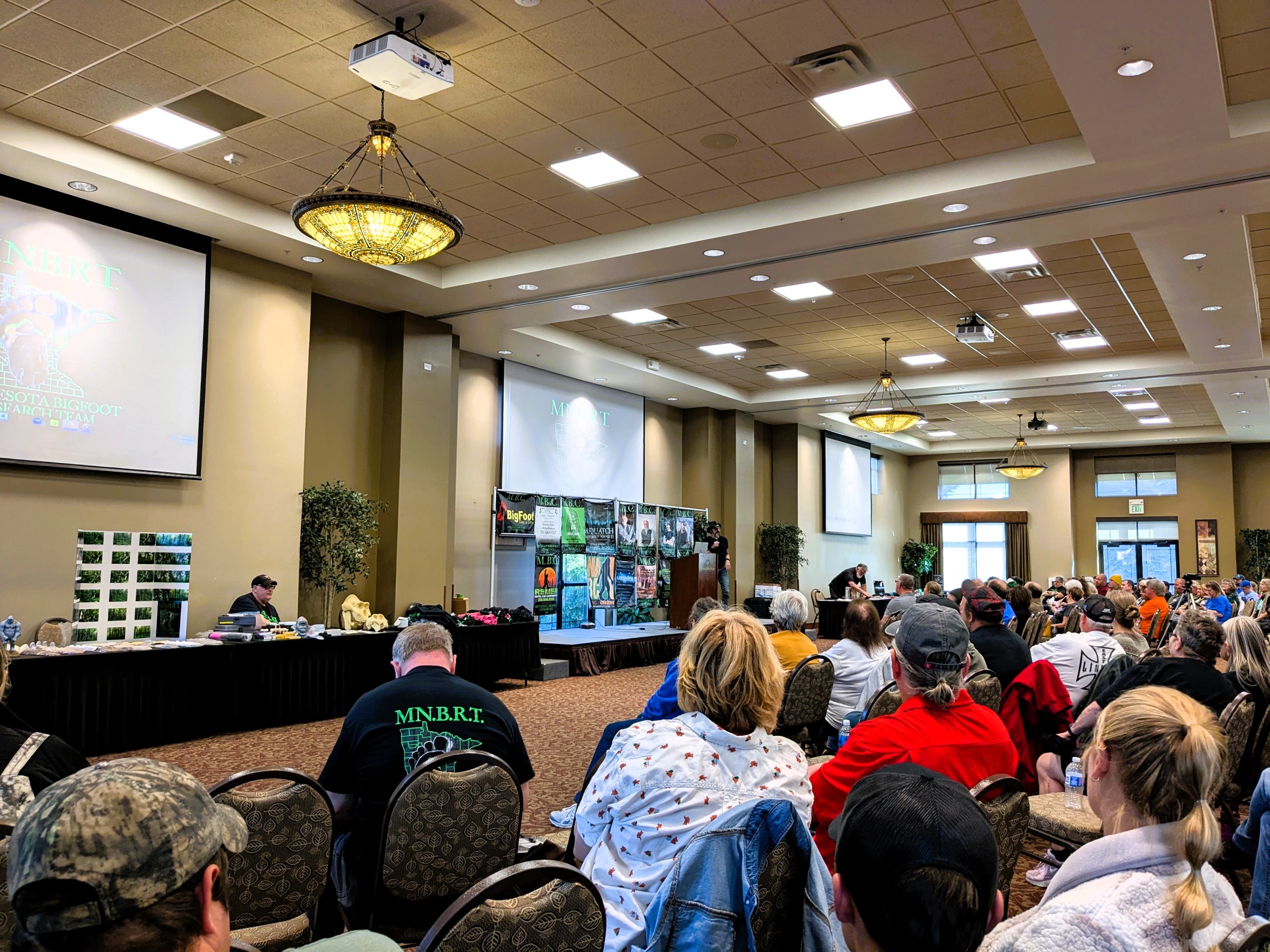Nothing could have prepared me for what I heard 30 minutes into the 2024 Minnesota Bigfoot Conference.
Cryptozoology-curious attendees were still trickling into the 10,000-square-foot Timberlake Lodge conference center in Grand Rapids, Minnesota, this past Saturday. Organizers told me they had pre-sold a record 350 tickets ($30 apiece), though walk-up sales ($40) were booming that breezy, overcast morning. The fifth-annual event, staged as always by the 10-member Minnesota Bigfoot Research Team, began with its usual “town hall” open mic, an opportunity for coffee-sipping guests to tell tales of—what else?—their past bigfoot encounters.
Affable and energized, MNBRT founder/organizer Abe Del Rio kicked things off with a mighty bigfoot howl, followed by a dramatic retelling of the mythical bipedal ape chasing him to his parked car in Coshocton County, Ohio, 23 years ago.
“You guys don’t have to be afraid to talk about it,” Del Rio assured the initially shy crowd. “I hope you do talk about it.”
Added northern Minnesota radio host/fellow MNBRT member Joel Sturgis: “That’s the biggest stigma—you’re only tough and macho until you have a 900-pound beast in your face!”
The first participant, an older and articulate woman, told of her 30+ bigfoot hunting exhibitions. A nervous younger fella with curly blonde hair was encouraged by supportive claps. “It was so nice to not be made fun of,” a middle-aged woman said, reflecting on last year’s conference.
Then, about a half-hour into the conference, Sturgis ferried the mic over to a gravelly voiced old-timer sporting a pushbroom mustache. He’d grown up near current-day Voyageurs National Park, working docks as a teen for tourists vacationing in Crane Lake. By 16, he would reportedly get involved in romantic trysts with the daughters of some visiting families. Here’s the first, and by far filthiest, moment my jaw dropped during that 12-hour day devoted to bigfoot, courtesy of the old-timer…
I was debating telling you the first story, but I don't see anybody too young in here. Chemistry is what it is, [me and a tourist] got into it. This is broad daylight. We're deep into it, I'm on top, and you can figure out the rest of it... She started screaming at me, and I couldn't figure out what I was doing wrong. She's pointing at me, I turn around to my right, and here's a young bigfoot. Now, I didn't know what a bigfoot was yet, and I'll be honest, he looks like anybody else between the ages of 14-18—long reddish hair, beard. Just one thing: He's not wearing any clothes, and he's got one thing in one hand if you catch my drift. And he's just looking at me, slobbering off his face like, 'Don't stop because of me.' I wanted to be the hero, and to get back to what I'm doing, so I gave him a side kick and caught him in the solar plex.
The story zigged and zagged plenty, but I believe he claimed to have shot that bigfoot, who was hopefully not just anybody else between the ages of 14-18, later that fateful day.
And with that, we were off!
Another hour of audience testimonials would follow, setting the table for a day of talks from esteemed bigfoot researchers, bigfoot calling contests for kids, ongoing raffles to win bigfoot merch, and, finally, a nightcap bonfire 25 minutes away in Remer, Minnesota—aka the (contested) “Home of Bigfoot.”
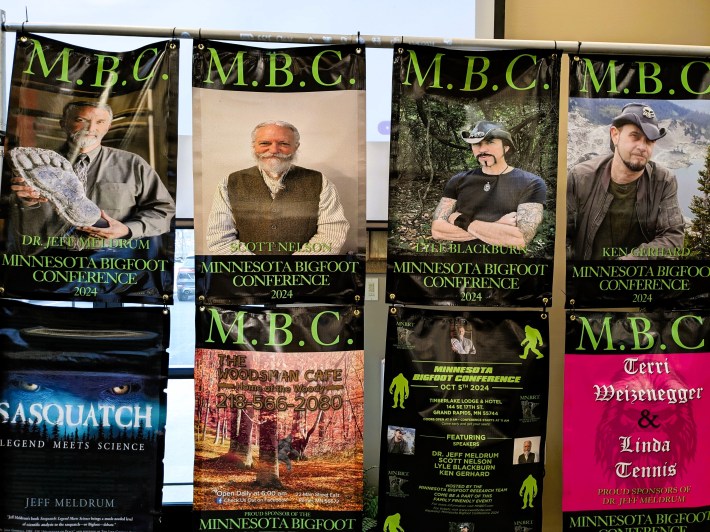
Unlike my past adventures in immersive oddball conference journalism, nary a whiff of hucksterism could be detected inside the Timberlake Lodge. The avalanche of evidence presented, at its most convincing, raised interesting questions about the possibility of an undiscovered North American primate species; even Jane Goodall, one of the most respected and famous scientists to ever live, hasn’t ruled out the possibility of bigfoot. At their most suspect, the presentations smacked of adult ghost stories juiced up by science-speak—no harm, no foul. (Unless some peeping Tom camper really did get gunned down…) Aside from the reasonably priced tickets, the only monetary asks came via killer merch (your reporter purchased a MNBRT T-shirt) and autographed book sales (entertainment, at the very least). A genuine, feel-good sense of community, believe it or not, percolated throughout.
The mindsets of attendees were predictably varied, with folks like Ben from Minneapolis approaching the conference with twinkly-eyed amusement.
"I saw the poster on Reddit, sent it to my buddy, and said, 'We're going,'” said the longhaired, jean-jacketed 20-something. “It's fun to be around people who are believers of weird paranormal stuff, whether or not the evidence supports it. I'm open to the idea. It's really just something to do on a Saturday. We went in blind."
Tom from Waconia attended with his college-aged daughter and her friend, a biology and environmental sciences major, who was “along for the ride.” For years he has studied books published by the day’s speakers, and was excited to hear from them firsthand.
"I'm like 195 years old, and I've always had an interest in bigfoot; that has been passed along to my oldest daughter,” he said. “When you’ve got thousands of reports by responsible people... you gotta know something is there.”
And there was no shortage of folks like Sue from Champlin.
"Oh yeah, we believe,” she said matter-of-factly. “He's real."
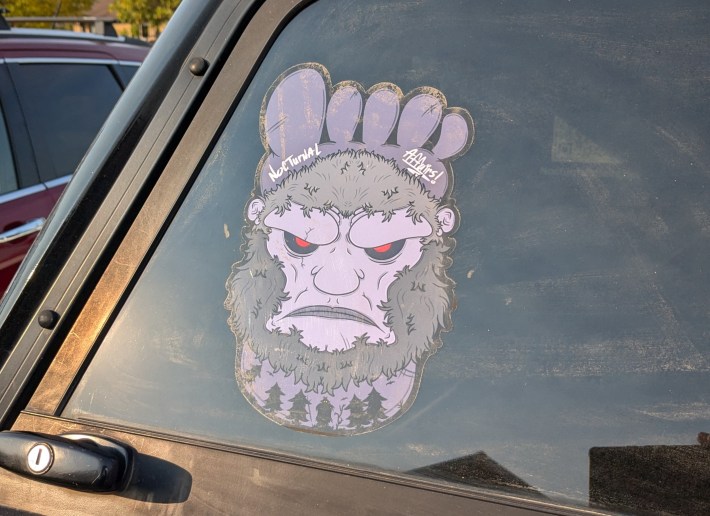
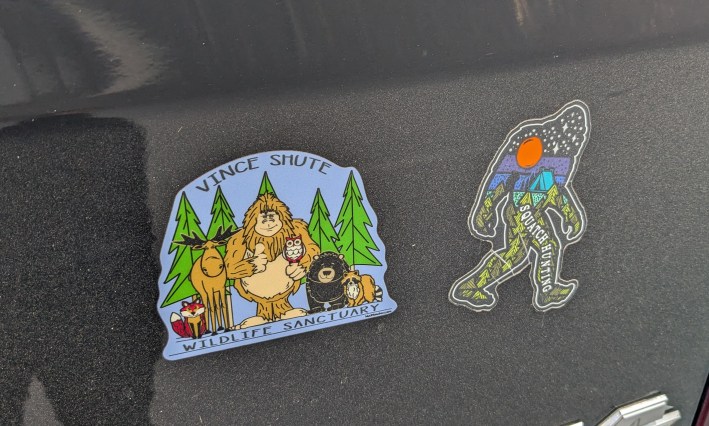
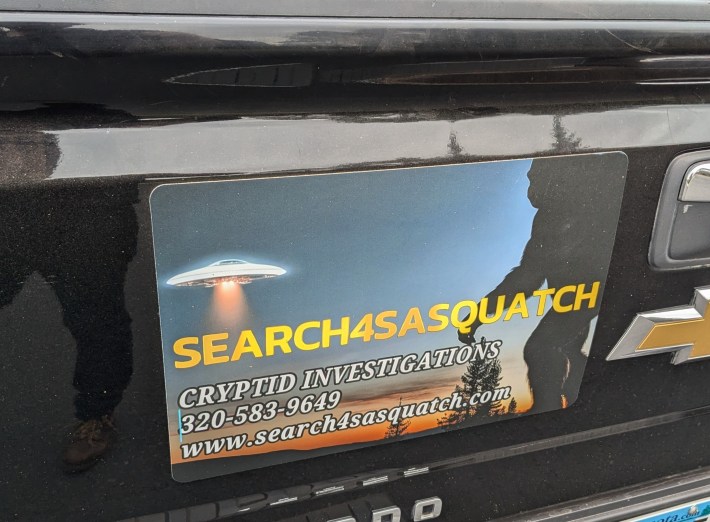
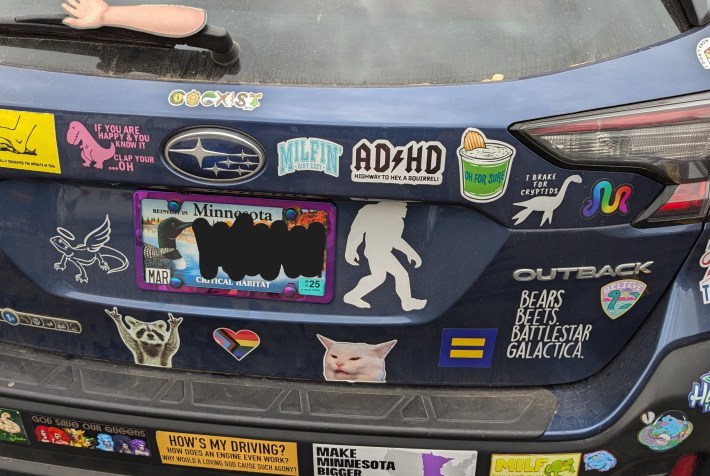
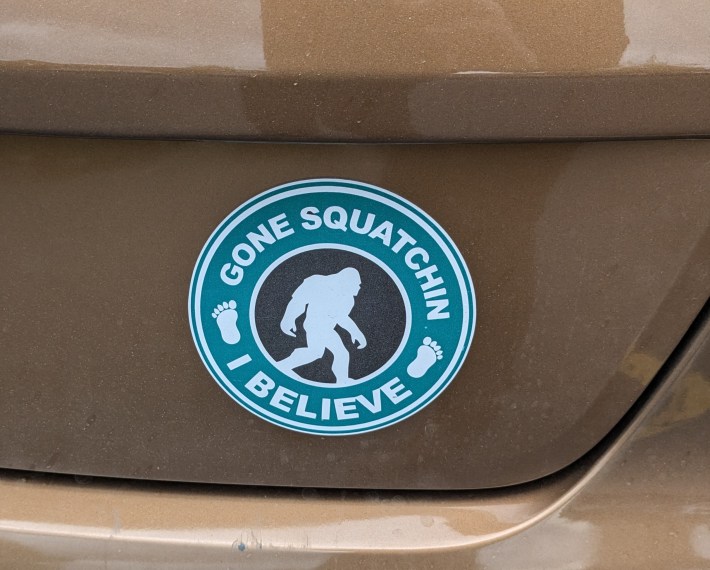
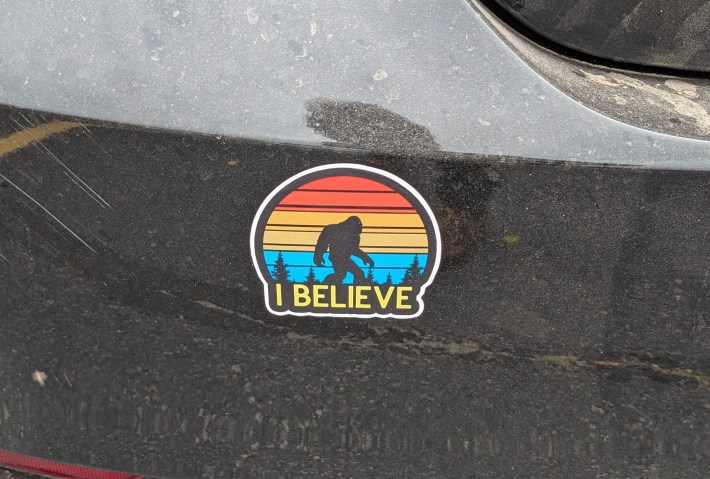
Scenes from the Timberlake Lodge parking lot.
Bigfooting: Hobby, Obsession, Passion
Long before he founded the Minnesota Bigfoot Research Team, Abe Del Rio was fascinated by and terrified of the gorillas at St. Paul’s Como Zoo.
“Don and Casey! They would put the fear of God in me in the ’80s when I was a little kid,” he said ahead of his group’s most recent conference. “I was awestruck."
(You might recall Casey, a 400-pound African gorilla, making national headlines when he briefly escaped the zoo in 1994.)
Bigfoot has maintained a zeitgeisty presence in American culture since the late 1950s. In 1972, the hairy cryptid docudrama The Legend of Boggy Creek became a surprise hit, and the 1987 fantasy-comedy film Harry and the Hendersons kept the legend vital into the ’90s when a spinoff sitcom emerged. But Del Rio says nothing created more bigfooters than the wave of reality TV documentaries that started in the ’00s: History’s MonsterQuest, Animal Planet’s Finding Bigfoot, Travel Channel’s Exhibition Bigfoot, and others. He believes that a Minnesota-based MonsterQuest producer/friend, Doug Hajicek, has helped popularize bigfoot in our state. These days 13% of U.S. adults say bigfoot is real, per recent polling, and there are bona fide pop and subculture movements built around the towering monkey men. (Among believers, it's widely suspected that North America is home to many examples of the bigfoot species.)
Del Rio established the MNBRT in 2000, and a year later the org’s first three members embarked on a hunt in Ohio’s “Sasquatch Triangle.” His brush with bigfoot there reignited a passion that began with Como Zoo gorillas, library books on bigfoot, and the still hotly debated Patterson–Gimlin film from 1967—you know, the famous grainy one with bigfoot walking through a riverbed, arms a-swingin'. Bob Gimlin, one of the filmmakers, was the first-ever keynote speaker at the Minnesota Bigfoot Conference.
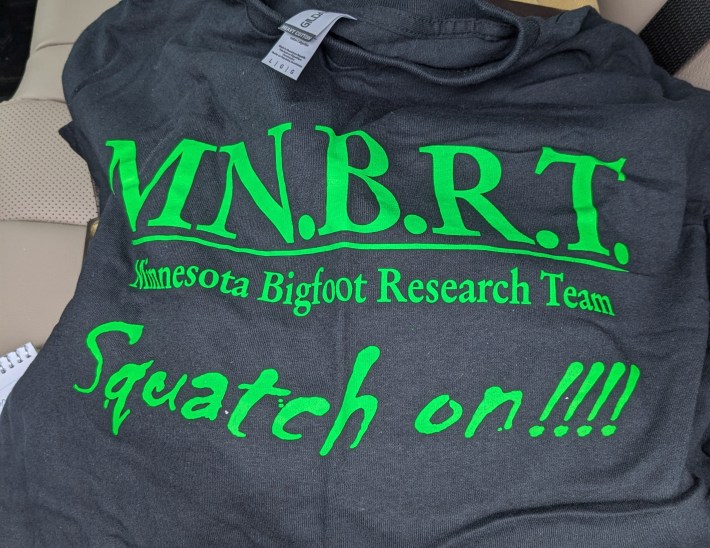
"My sighting in Ohio added fuel to the fire; I had my own fuel refinery lit," says Del Rio, who runs his own HVAC cleaning business when he’s not tromping through the forest every other weekend. "All this started out as a hobby, it grew into an obsession, and now it's a passion that I love."
The MNBRT has conducted “probably thousands” of exhibitions, its founder says, and an adherence to facts undergirds the enterprise. For example, the school of bigfooter who believes the beast can turn invisible, was sent by UFOs, and has telepathic abilities? Del Rio says they "cause this community to be laughed at—I want nothing to do with them.”
The conference has never been a money maker. That’s not the point.
“I'm down every year from the conference. But it has never been about money—it's about the preservation, the conservation, and the protection of this creature,” Del Rio says. “It's also about having a trust and a rapport with people, where they feel safe. Even in the late ’90s, we were being called crazy, 'You're a drunk, you're on drugs!' There are people who do not come out because they fear being ridiculed about their bigfoot encounters.”
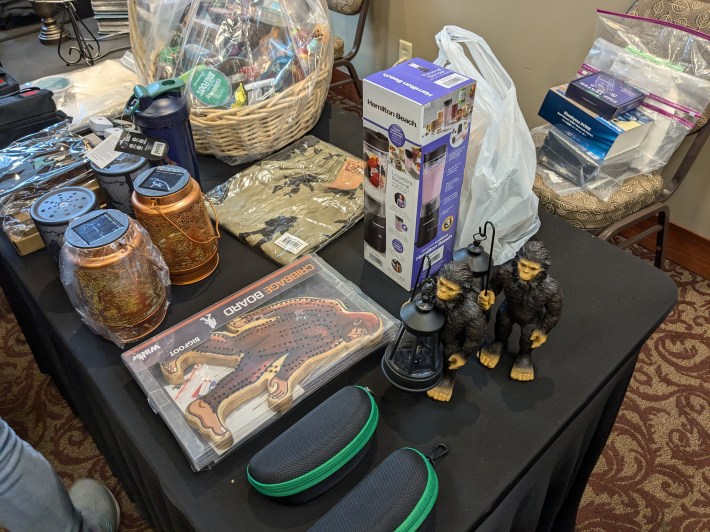
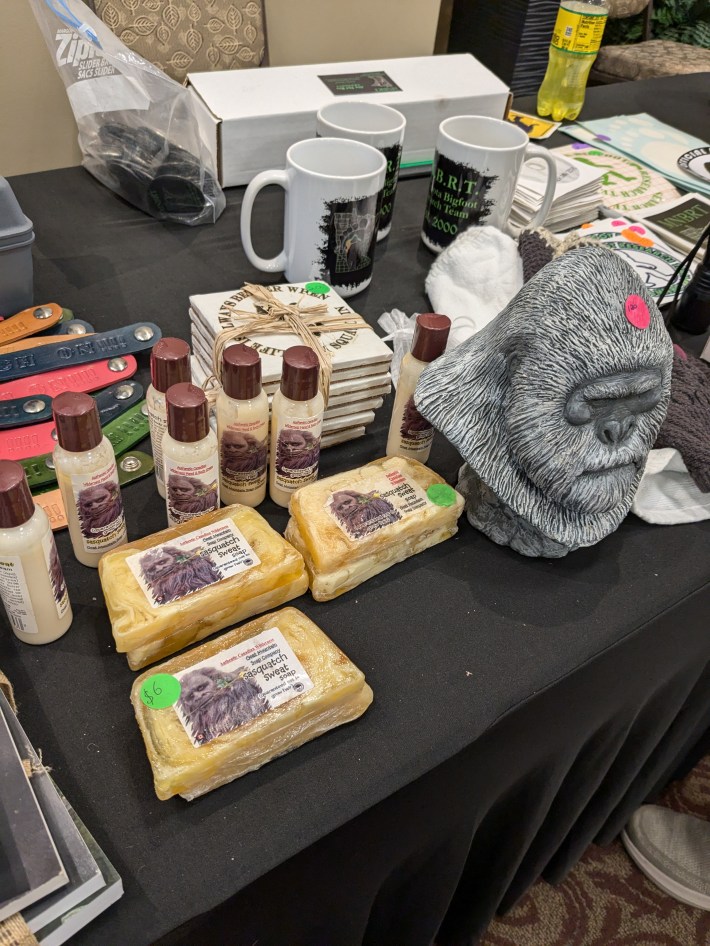
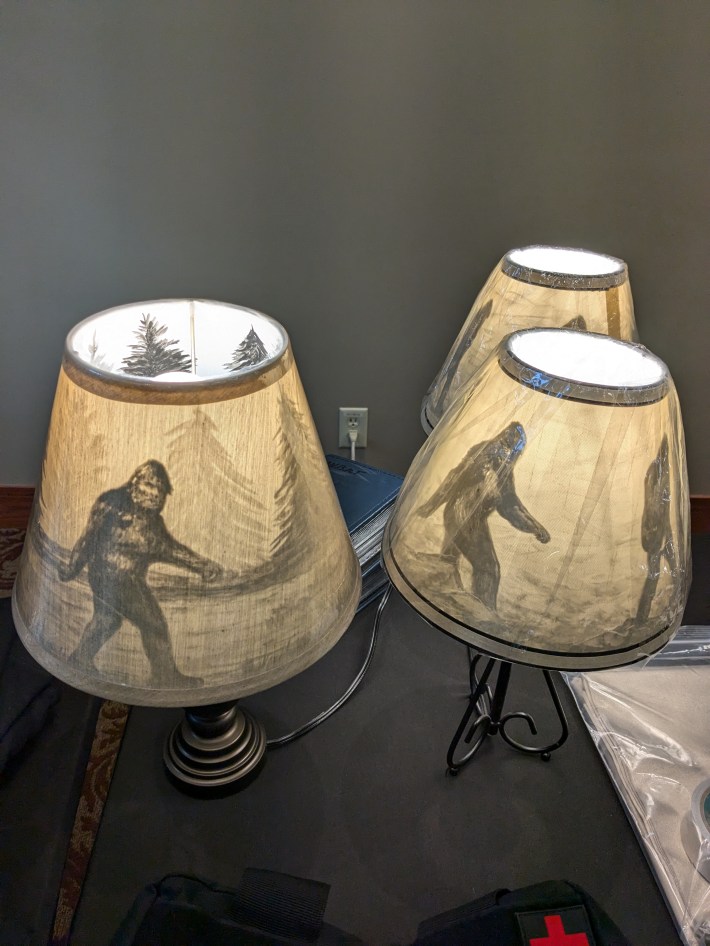
Merch and raffle goodies from the 2024 Minnesota Bigfoot Conference.
The Southern Sasquatch
Back inside the hangar-like beige event center, the conference’s first speaker, author/musician/hot sauce salesman Lyle Blackburn, took the stage rocking his trademark cowboy hat and Fu Manchu mustache. Technical hiccups with his PowerPoint slides were smoothed out as a country song about cryptids played over the PA.
“Nobody said we’re good at technology,” the Texan drawled with surplus charisma. “That’s why we can’t get images of bigfoot, obviously.”
Of all the presentations, Blackburn’s was lightest on science, instead focusing on the history of the Fouke Monster from The Legend of Boggy Creek, a subject on which he has authored several books. Known to some as “the Southern Sasquatch,” the Fouke Monster has reportedly roamed the Sulphur River swamplands around Fouke, Arkansas, for decades. Local news stories on its alleged attack on two homeowners in 1971 became the focus of the hit movie.
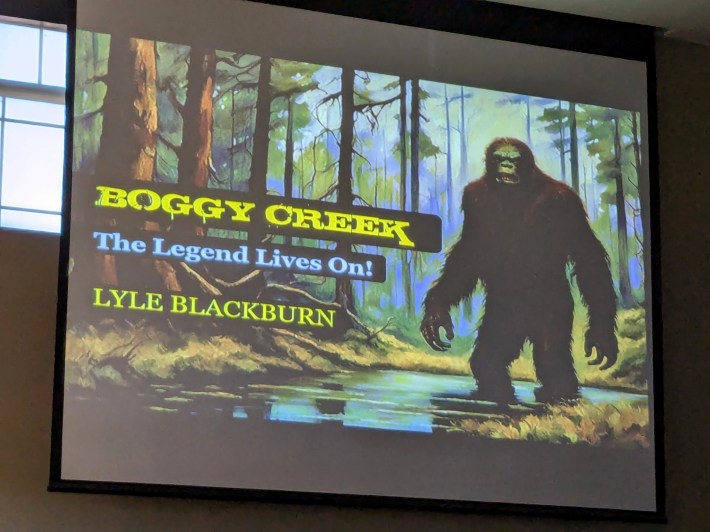
Blackburn’s own investigations find him hiking through those swamps with regularity. He has discovered apparent tracks, a “boneyard” of assembled hog and deer skeletons, and, unfortunately, no clear photos of the monster. But, he says, cryptid hunters still hear its telltale knocks, taps, and whoops, proving that the glowing-eyed bipedal creature is “still up to its old tricks” of stalking nearby homes.
“The only way I could describe it is like a living shadow,” Blackburn said of his own sighting. “I couldn’t take a picture, there was no time!”
Things concluded with an audience Q&A where Blackburn fielded questioned about whether missing people in the area could’ve been claimed by the Fouke Monster (“it could very well connect”), whether the monster is actually Dogman (inconclusive), and cryptid-hunting tips for newbies (“stay safe and have fun out there”).
By this point, around 11:30 a.m., a handful of audience members were already sipping beers and cocktails from the adjoining hotel bar.
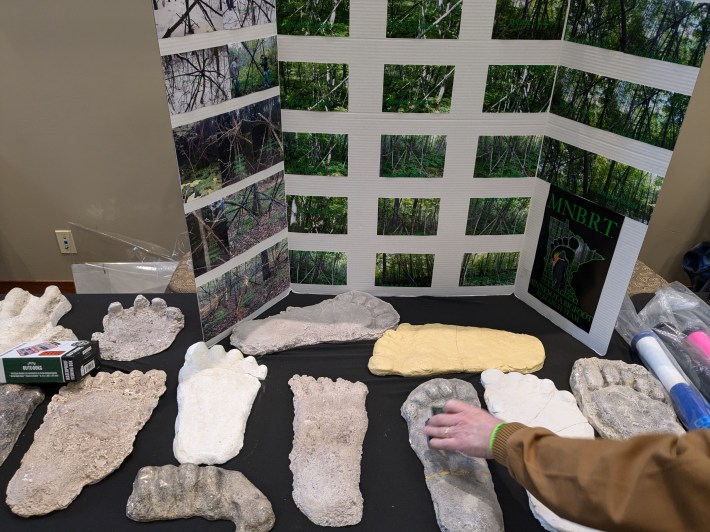
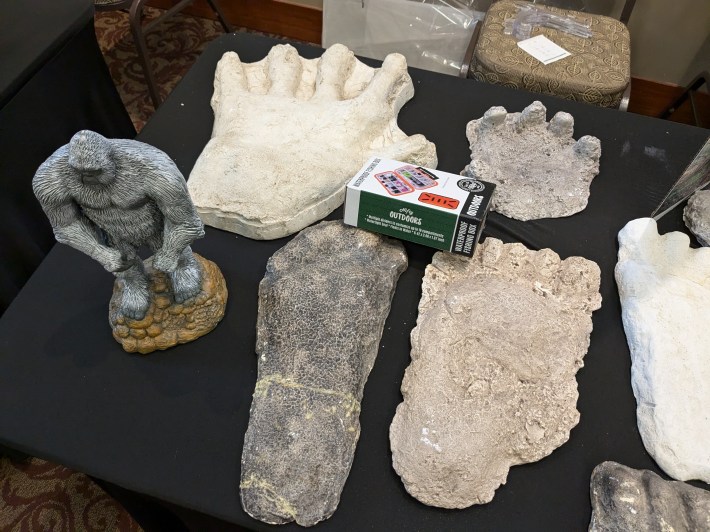
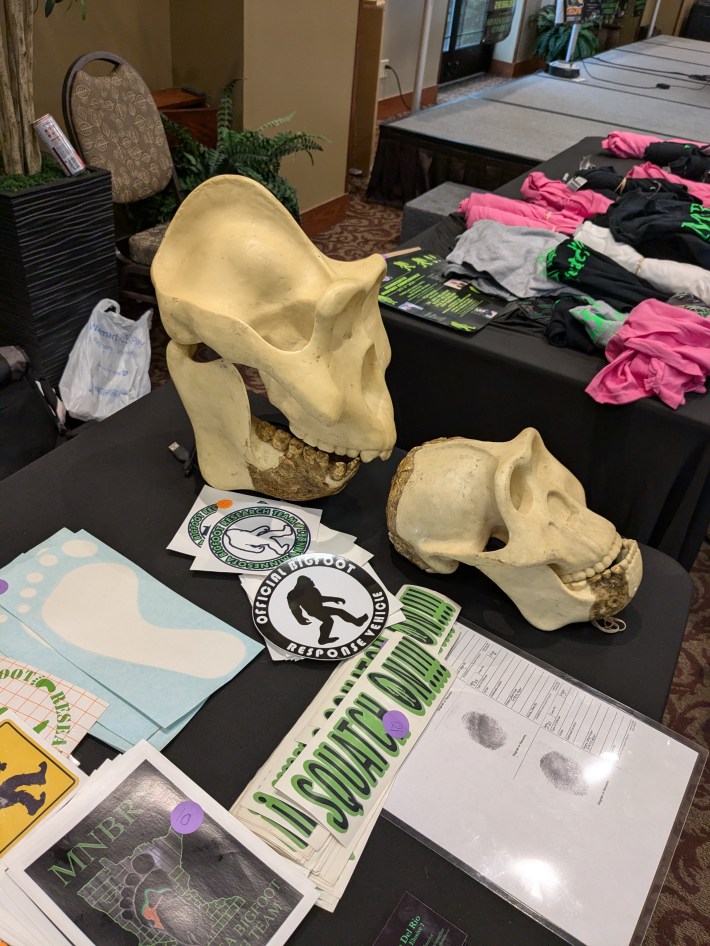
A table of bigfoot evidence.
Loch Ness Monster Vs. Bigfoot
As a cryptozoologist, Ken Gerhard brought a bit more scientific oomph to the Timberlake Lodge, though he, too, rocked a cowboy hat. The field investigator/author is a veteran talking head on shows like MonsterQuest and Syfy’s Weird or What? featuring William Shatner, in addition to his radio appearances on the venerable paranormal conspiracy radio show Coast to Coast, former home to the late, great host Art Bell.
Gerhard also brought a fun gimmick with him to Minnesota: His presentation offered facts in support of the Loch Ness monster, followed by his case for bigfoot, and concluded with an audience poll of which cryptid seems more plausible. (Spoiler: Sasquatch won in a landslide.)
Gerhard got hooked on the world of cryptozoology as a teen during a family visit to Loch Ness, the deep, narrow, and frigid freshwater lake that juts through the Scottish Highlands. His sprinkling in of terms like “Devonian Period” (400 million years ago, during the Paleozoic era) and “Basilosaurus theory” (about the ongoing discovery of deep-sea creatures) added zoological cachet, at least rhetorically.
Gerhard shared slides with photos of his own Loch Ness expeditions over the years, and debunked several notable Loch Ness monster photos that he deemed hoaxes. Interestingly, he dismissed the very basis of photographic evidence circa 2024: “With AI and Photoshop, it’s not going to cut it.”
Inconclusive results from a 1987 flotilla that scanned Loch Ness with sonar technology proved “very interesting,” Gerhard observed, and a so-called Lake Monster Belt—with Nessie-like creatures rumored around the globe, including in Lake Superior, all between 40 and 65 degrees longitude North—amused this reporter. Could a serpentine, ancient whale-lake creature have evaded discovery deep beneath the dark waters of Loch Ness? Sure, why not?
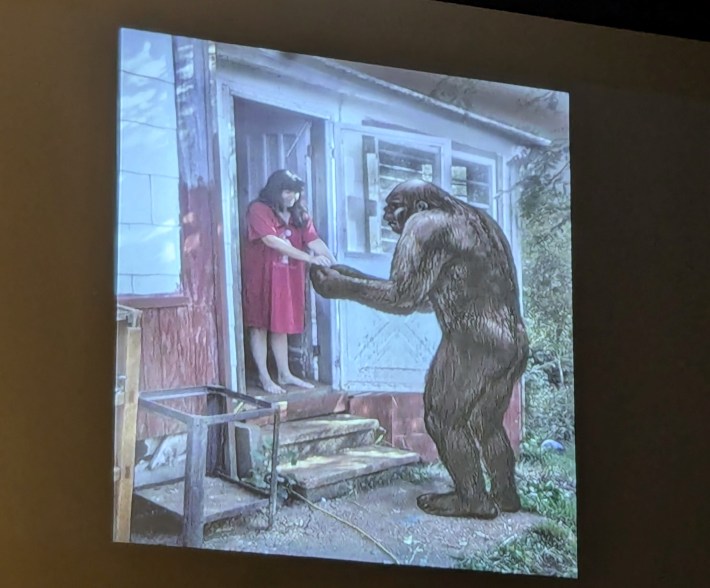
If hard evidence for the Loch Ness monster is in short supply, potential proof of bigfoot being an “unfound species” abounds, Gerhard believes. The fact that many Native American tribes produced art of bigfoot-like creatures, despite this continent being ape-free? Pretty wild stuff. Over 1,000 documented footprints and handprints vibe with the fossil record, he said, concluding that bigfoot “should exist.”
But!
There’s “no evidence” of extraterrestrial involvement, Gerhard stressed, and theories like government cover ups, mindspeak, and cloaking don’t carry any water. Anecdotes from people claiming to have befriended bigfoot, like the depiction above, shouldn’t be trusted, he said.
Bigfoot’s Big Butt (And Other Hard Evidence)
Following a 1.5-hour break for lunch (“Lunch on your own,” the itinerary stressed), conference-goers reassembled for the day’s rock-star speaker: Dr. Jeff Meldrum, an anthropology professor from Idaho State University.
But Dr. Meldrum is no humble academic; the avuncular Mormon, whose voice sounds more than a little like Will Ferrell’s, is the big kahuna expert of the bigfooter world. He starred in a major 2003 Discovery documentary, Sasquatch: Legend Meets Science, from producer Doug Hajicek (remember him?) and narrator Stacy Keach (huh!).
Three years later, Meldrum authored a companion book that landed him a longform interview on the ultimate sober, analytical news outlet: NPR. (Worth noting: In its review, the magazine Skeptical Inquirer was far from persuaded, calling Sasquatch: Legend Meets Science “pseudoscience.”) The professor would become a news media and TV docuseries fixture, appearing whenever somebody needs sober, analytical bigfoot commentary. Just last week,TMZ invited Meldrum on to help debunk a TikTok-based sasquatch hoax.
At our northern Minnesota hotel, Meldrum held court with the bearded authoritativeness of a scholar. Despite his engaging style, the 90-minute lecture did, at times, feel like being back in college. The Patterson-Gimlin clip was dissected frame-by-frame like a less consequential Zapruder film, with Meldrum testifying that Bob Gimlin is “a Boy Scout, a straight arrow” who must be trusted.
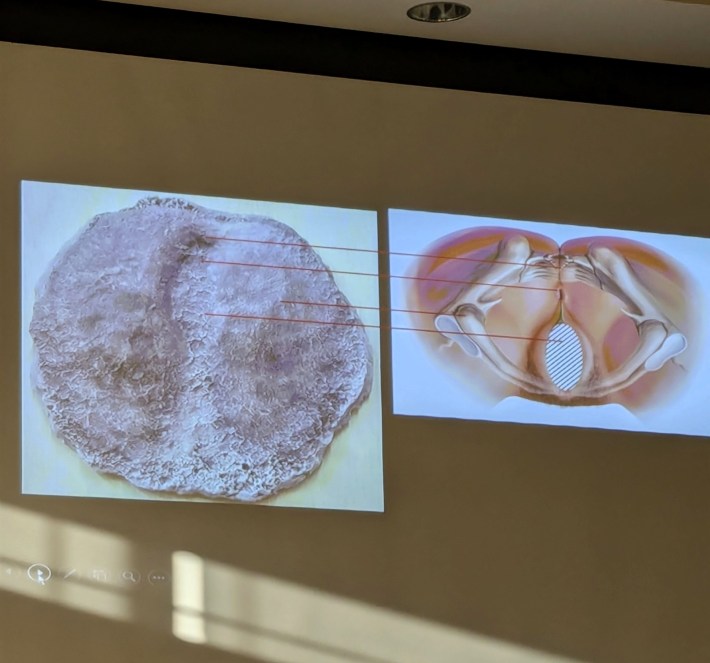
There was a lot of discussion about bigfoot’s ample ass (see image above). The beast boasts “quite well-developed gluteals,” the professor explained, while drawing attention to the “puckered sphincter” visible on one casting of an alleged bigfoot buttprint (again, sorry, look even closer above).
“What hoaxer would have the wherewithal to sculpt like this?” he said of the Patterson-Gimlin bigfoot’s rear. “It boggles the mind.”
Fans of hyper-analysis of the “midtarsal pressure ridge” imprint on bigfoot print castings found a lot to like, as did folks yearning for granular discussions about the differences between image grain vs. image pixels. At one point Meldrum used his “petite” ex-wife’s “light skeleton” to make some sort of point about the structure of ape-like toes. Throughout, he hammered home the fallacy of experts who dismissed the Patterson-Gimlin film upon its release.
“They said, ‘It can’t exist therefore it does not exist,’” Meldrum observed with a smirk. “They were wrong.”
The audience couldn’t get enough of the distinguished and loquacious bigfoot doc, as his Q&A segment stretched well past the 90-minute mark. At no point did the conference reach a larger intellectual gulf from the bigfoot jackoff guy than with Dr. Meldrum.
The Call of Bigfoot
By the time Scott Nelson took the stage, about a third of the conference hall had cleared out. Only true bigfoot fanatics and at least one tired reporter remained. (I’d hit the road from south Minneapolis at 5:30 a.m.—gimme a break!)
Nelson, a retired U.S. Navy linguist with a swaggering, Sean Connery-esque brogue, became infatuated by bigfoot 15 years ago. That’s when he first heard the “Sierra Sounds” tapes, which contain 90+ minutes of audible bigfoot yelps, chirps, barks, howls, grunts, and snorts, according to believers.
“If that’s a bigfoot, it has a language,” Nelson concluded after first hearing the audio captured in California’s Sierra Nevada mountains. “That is not gibberish! Although gibberish implies language with semantic meaning…”
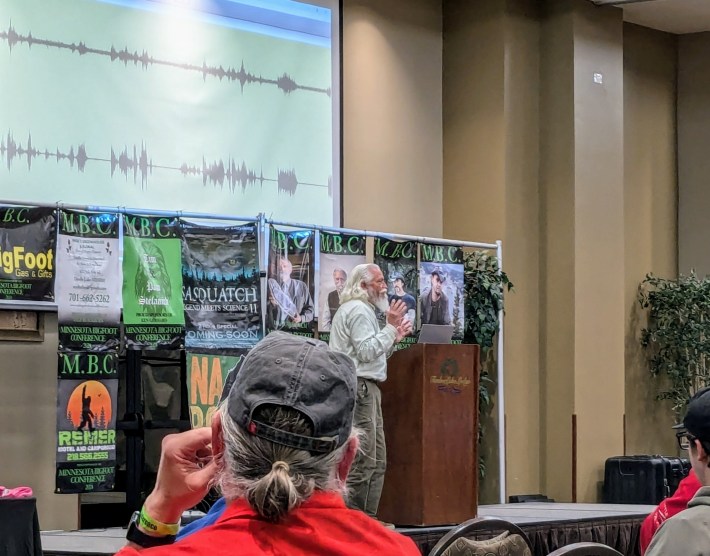
The “Sierra Sounds” tapes date back to 1972, when a group of hunters purportedly lured a family of sasquatches to their camp by setting out a large pot of stew. Other linguists, like Karen Stollznow writing in Scientific American, have dismissed the tapes as a hoax, but Nelson is convinced they’re real. He transcribed them over the course of four months to correspond with the NATO phonetic alphabet, thus creating something he calls the sasquatch phonetic alphabet. He says years of cracking Russian code for the Navy sharpened his insights, and 10 exhibitions to the alleged site of the recordings have only hardened his resolve.
“I knew it couldn’t be fake because of professional experience,” he said. “Nobody has listened to more human voice on tape than me.”
Nelson veered off course a few times, undercutting his authoritativeness. Recounting multiple beefs with minor podcasters didn’t help his case, neither did a joke where he repeated the attempted punchline “mentally retarded sasquatch” three times. His Q&A portion featured more contentious exchanges than with previous speakers, too—Dr. Meldrum even grilled him from the dais!
Yet Nelson returned again and again to his considerable linguistic prowess, though he left room for doubt.
“These could be demons as far as I know! They could be angels!” he said, reflecting on his time in the Sierras. “They kept themselves hidden.”
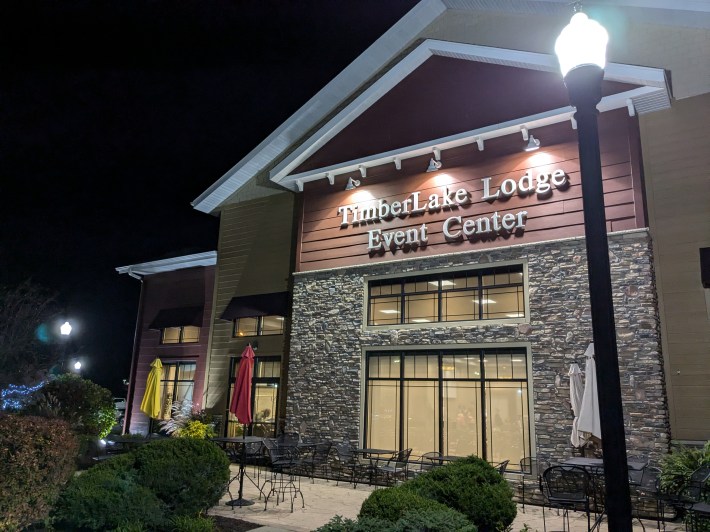
As the clock ticked past 9 p.m., my reserve of energy proved too faded to make it to the campground bonfire out in Remer. Determined to earn my keep as a journalist, I quickly conducted 10 interviews with conference-goers, all of whom reported a lovely marathon day of bigfootery at the Timberlake Lodge.
"I'm a lifelong bigfoot fan, so it was a lot of fun. Everybody believes, I really think, there are bigfoots, and... I don't know!" Ginny from Excelsior said with a nervous chuckle.
"Last year we left early, right after lunch, and there were about a third as many people. We had to come back this year to hear Jeff Meldrum,” said Greg from Crosby, who may or may not have witnessed a bigfoot in 1973. “We'll probably be back next year… we have to pick up gifts for my wife’s brother."
I then slinked out of the hotel, grabbed dinner at Culver’s and Ursa Minor IPAs from the liquor store, and retreated back to my dated spa suite. As I opened the door, ready to crash into bed with the force of a bigfoot, I heard a debate being conducted from the lobby. There was Dr. Meldrum, still grilling Nelson with friendly-yet-probing questions about “bigfoot vocal cadences.”
“Well, I suppose I’m ready for a bonfire,” Nelson said.
With that, the retirement-age bigfoot researchers stepped foot into the parking lot just shy of 10 p.m., ready for their 25-minute drive through the woods to socialize with fellow bigfooters. You can question the existence of sasquatch, but you can’t question the enthusiasm of his true believers.
